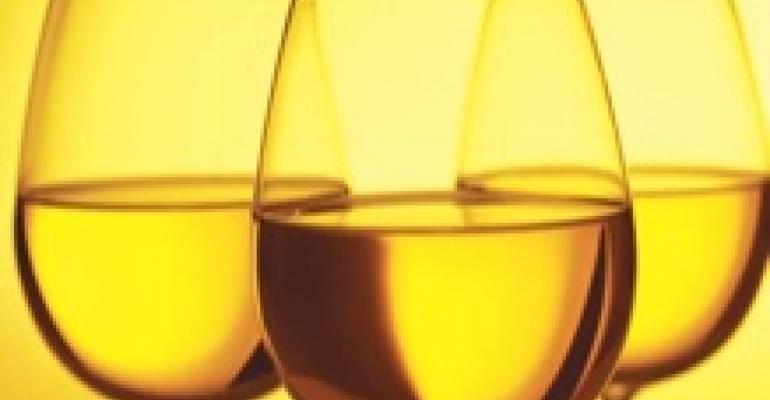—-Trudy Thomas
 Anything But Chardonnay or Anything But Cabernet—or ABC, as it is more commonly called—is an attitude that's becoming more of a concern for restaurateurs, as America continues to explore and learn more about wine.
Anything But Chardonnay or Anything But Cabernet—or ABC, as it is more commonly called—is an attitude that's becoming more of a concern for restaurateurs, as America continues to explore and learn more about wine.
The Queen and King of the wine world are still the foundation of restaurant programs around the country for good reasons: Chardonnay and Cabernet are amazingly complex, richly flavorful varietals that improve with age. However, during summer days when temperatures soar, Chards and Cabs have a tendency to be too big and too heavy, which creates the perfect opportunity for restaurants to increase wine sales by offering lesser-known varietals.
Although wine consumption continues to rise in the U.S., some restaurateurs consider "alternative" wines a big risk, especially for wine-by-the-glass programs where waste becomes a factor. Traditionally, a glass list is composed of classic wines, and non-classic alternatives are listed as bottle selections only. While tried and true comfort labels continue to dominate consumer choices, especially when the investment is a full bottle, the reality is that consumers are now more adventurous and willing to try something new. They're eager to learn about wine, and the best way to do that is by tasting it. What more affordable way to do that than by ordering by-the-glass, where the patron's investment and risk are smaller? These habits are making the wine by-the-glass category the fastest growth segment among restaurant wine programs, resulting in numbers reaching as much as 40% of total wine sales. With numbers this strong and increasing, the potential gain in profit lessens the risk of bringing on new varietals.
The amount and type of wine to feature for the summer will depend on your menu concept and the depth of your wine program. For most restaurants, adding simple, easy-to-recognize varietals is the best option, along with selecting producers familiar to both the customer base and the service team. Wine is an exploration, and the experience of wine varies from person to person, so the rules of pairing food and wine are not set in stone. However, there are six domestically produced varietals which have the proper acidity and natural flavors to play up summer fare: Sauvignon Blanc, Riesling, Viognier, Merlot, Syrah and Zinfandel.
Sauvignon Blanc: This white wine is high in acid, and goes with a wide range of food and food preparations. Sauvignon Blanc is tart and tangy, full of crisp citrus flavors, and can taste herbaceous. The oak influence makes it fuller and rounder. Try it with fresh garden salads, with tomatoes, summer squash and asparagus dishes that are notoriously difficult to pair with wine, but are no problem when matched with Sauvignon Blanc's high acidity and grassy aromatics.
Riesling: Riesling sales are on the rise. Light and fragrant, this versatile wine ranges in style from sticky sweet to bone dry. California and Washington State produce amazing Rieslings, as do New York and Michigan. Riesling is a seafood wine, and because of its lower alcohol and occasional residual sugar, it holds up to the hottest spice.
Viognier: Althought not as recognized as Sauvignon Blanc or Riesling, Viognier is gaining recognition around the country. The wine is full and somewhat oily in texture, but has great acidity and is jam-packed with ripe tropical fruit. Domestically, California and Virginia are producing exceptional examples. Its opulence makes it a fantastic food wine to enhance heavier summer fare like grilled fish and fried chicken.
Zinfandel: No matter what style barbecue you serve, Zinfandel is a natural choice. It's considered America's grape, and produces a rich, jammy, fruit-filled wine with loads of spice, often high in alcohol. Zinfandel is an all-around favorite with everyday foods like brats, hamburgers, pizza, and smoked or grilled meats.
Syrah: This grape, native to France's Northern Rhone region, is rich and dark with a hint of mint. The best examples come from Southern California. Known as Shiraz in Australia and South Africa, Syrah is a great alternative to Cabernet Sauvignon and is best served with grilled meats.
Merlot: Although it is still a noble grape variety, during the past few years, Merlot has lost a little bit of its luster (mostly due to unflattering references in media and in the movie, Sideways). Merlot has blackberry, currant and plum aromas and flavors, along with occasional green pepper and olive flavors when grown in cooler climates, finishing with soft, approachable tannins. When choosing Merlot for summer fare, look for those made in Washington State, where the grape excels. Instead of Cabernet, select Merlot to pair with grilled meat, fresh herb-based dishes and any item with mushrooms, as these foods bring out the earthy character of the wine.
One often overlooked point to remember when serving wine this summer is the temperature, especially for patio service. Summer sunshine can quickly heat up a bottle of wine, red or white, so as temperatures soar don't forget to keep your wines in a cool place. Red wines will benefit from a slight ice bucket chill, as long as they are not left in the ice too long.
Trudy Thomas is president of Liquid Remedy beverage consulting company.
| Beverage Testing Institute's Recommended Wines for Restaurant Lists
White Wine Glass Pour Recommendations White Wine Bottle List Recommendations Red Wine Glass Pour Recommendations Red Wine Bottle List Recommendations |
BANANASTOCK


 All prices of wines reviewed by the Beverage Testing Institute are retail. Check with local distributors or the wineries, for wholesale pricing and availability.
All prices of wines reviewed by the Beverage Testing Institute are retail. Check with local distributors or the wineries, for wholesale pricing and availability.


